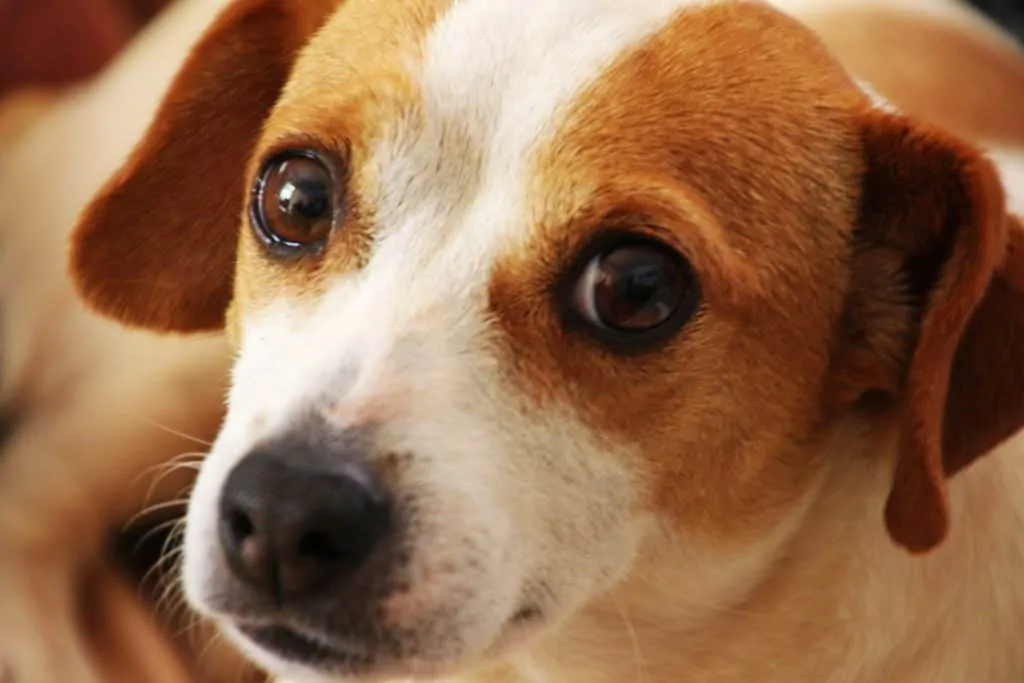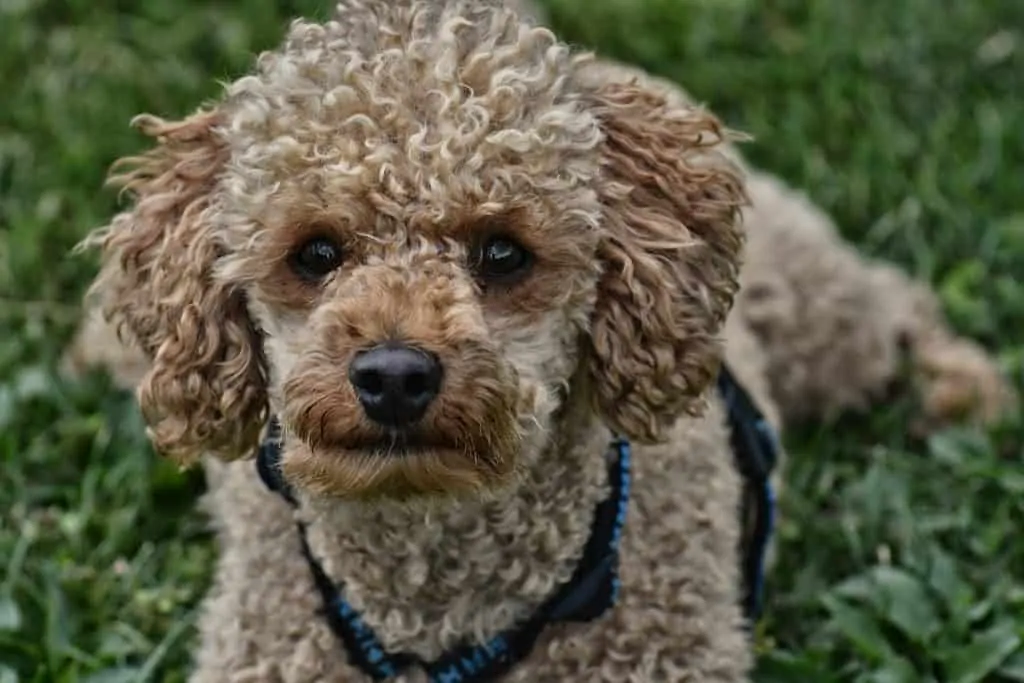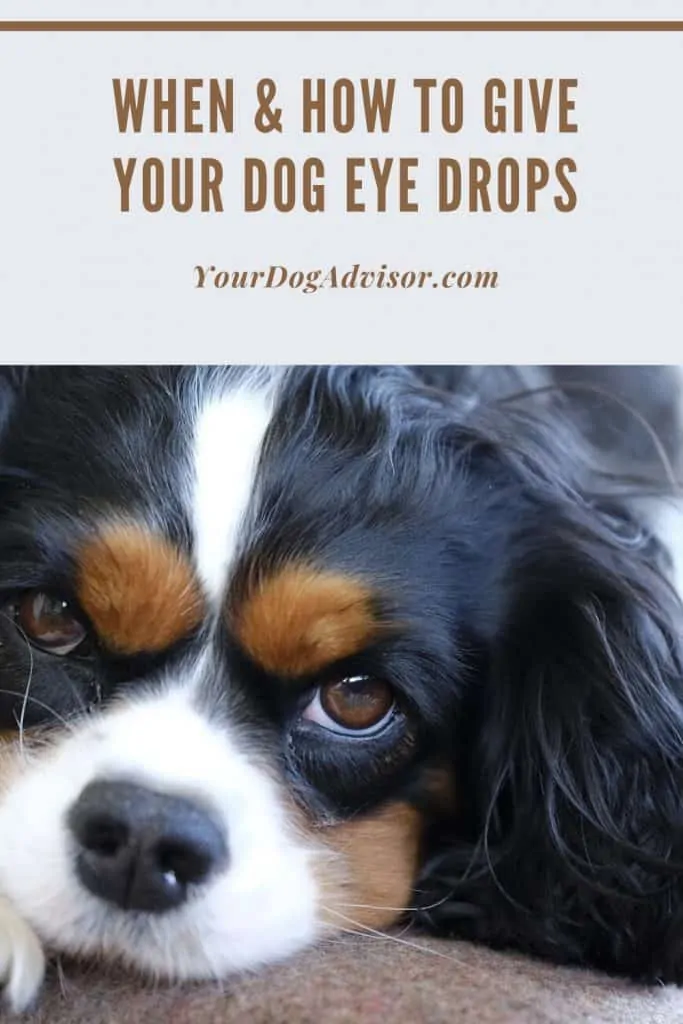Any problem involving the eye has the potential to be quite serious. This is true in humans and doubly so in dogs. Since our canine companions can’t tell us what happened to them or give us a list of symptoms, it’s important that we take any changes in a dog’s eyes seriously. That means all but the most minor eye issues should be evaluated by a veterinarian within 12 hours from when symptoms first appeared.
Your dog’s eyes are precious, so make sure you call your vet if you notice anything unusual. Most problems should be evaluated within one day or less.
The symptoms of eye problems are many and varied, but the most common include:
- Squinting
- Excessive blinking
- Excessive tearing
- Rubbing the eye(s)
- Redness
- Swelling in or around the eye
- Yellow or green drainage
- Excess mucus
Any of these may be a sign of a minor problem such as viral infection or an allergy. But it can also indicate a much more serious condition like glaucoma or a traumatic injury to the eye. So always err on the side of caution and have your dog evaluated by your vet.
Contents
When Are Eye Drops Indicated for a Dog?
If you notice your dog’s eye (or eyes) appear irritated, your first step should be to examine the eye and note what you see. If there is no obvious injury, cleaning your dog’s eyes with a buffered solution of sterile saline may help to wash away any irritants or debris, says Dr. Patricia J. Smith, MS, DVM on PetMD. In fact, it’s a good idea to have this simple eye wash on hand at all times to deal with minor eye emergencies for you and your pets. You may also use human-grade artificial tears such as Visine or Thera-tears, but always check with your vet first. A cool cloth over the dog’s eyes may also provide some relief.
In most cases, however, simply cleaning your dog’s eyes with a saline solution won’t resolve what’s going on. In that case, your vet will recommend eye drops that are appropriate for his symptoms and the underlying condition causing them. These may include any number of prescription and over-the-counter remedies. Here is a brief overview of some of the most common and the conditions they treat.
Antibiotic Eye Drops
Antibiotic eye drops are a staple treatment of eye problems in dogs. They are often prescribed to treat conjunctivitis — a condition in which the outer layer of the eyeball (the conjunctiva) is red and inflamed. Conjunctivitis can have many causes, including:
- Bacterial or viral infections
- Seasonal allergies
- Traumatic injury to the eye
- Irritation from smoke or pollutants
- Obstructed tear ducts
- Tear film abnormalities
- Inherited or breed specific disorders such as nodular granulomatous episcleritis, an inflammatory disorder seen in collies, cocker spaniels and similar breeds.
- Eyelid disorders such as entropion, a painful condition in which the eyelid turns inward, causing the eyelashes to rub against the cornea and irritate the eye
According to VCA Animal Hospitals, your vet may prescribe one of a variety of antibiotics, such as chloramphenicol, ciprofloxacin, gentamicin, oxytetracycline, or tobramycin, to treat your dog’s conjunctivitis, depending on the suspected cause. In some instances, she may prescribe an antibiotic ointment as well. In that case, always put the drops in your dog’s eyes first since the ointment forms a film over the eye that will interfere with the absorption of the drops. Continue using the drops for the full amount of time prescribed by your vet, even if your dog’s symptoms improve.
Most cases of conjunctivitis quickly resolve with appropriate treatment. However, as we will discuss later, some cases are caused by more complex conditions that require surgical intervention and/or lifelong care.
Dogs with conjunctivitis will have red, weepy, swollen eyes. If the eye is infected, there may be yellow or green discharge present as well.
Source: Photo by Carol Foil, own work, via wikipedia.org licensed under CC by SA 3.0
Anti-inflammatory Eye Drops
In addition to antibiotic eye drops, anti-inflammatory drops are frequently prescribed by vets to treat inflammation in the eye. Inflammation can be due to a number of causes, including allergic reactions, irritation by pollutants, entropion or uveitis, — a painful condition caused by inflammation of the uvea, a structure within the eye that includes the iris (the colored portion of the eye), the ciliary body, which makes the aqueous humor (the fluid that fills the eye), and the choroid, the middle layer within the eye. Inflammation may also occur after trauma to the eye or surgery.
Anti-inflammatory eye drops are typically steroids or nonsteroidal antiinflammatories (NSAIDs). According to Today’s Veterinary Practice, some commonly prescribed steroid drops include prednisolone acetate and dexamethasone. For severe inflammation (for example, from uveitis) these are usually given every 3 to 6 hours for a period of several weeks. Less severe inflammation may require less frequent applications over a shorter period of time.
Nonsteroidal anti-inflammatory eye drops include diclofenac, flurbiprofen and ketorolac. These medications are less potent than steroids, but may be a better choice if the inflammation in the eye is associated with a corneal injury or ulceration, since steroids may delay wound healing and increase the likelihood of infection. NSAIDs may also be used as an adjunct to steroids if inflammation is severe.
NSAID eye drops are usually given every 6 to 12 hours until the inflammation resolves. When treating chronic conditions, your vet may recommend that you continue the drops once or twice daily indefinitely.
Eye Drops that Stimulate Tear Production
Keratoconjunctivitis sicca (KCS) is a common eye disease in dogs. Often referred to as “dry eye,” it is a disorder in which the lacrimal glands fail to produce enough tear film to keep the surface of the eye moist. Tear film is made up of water, mucus and a fatty liquid; most cases of KCS are the result of inadequate production of the watery component of tears.
KCS has several causes, but the most common is a poorly understood immune defect that causes the dog’s own immune system to attack the lacrimal glands. It may also be related to viral infections, the side effects of certain drugs, or hypothyroidism. There is also a form of the disease known as neurogenic KCS, which results from an infection and sometimes a tumor in the inner ear.
Cavalier King Charles spaniels are prone to KCS. But you can save those gorgeous eyes if you follow your vet’s advice and give her eye medicine every single day.
Dry eye can happen to any dog, but is more common in certain breeds. According to VCA Hospitals these include:
- Spaniels, such as the American cocker spaniel, Springer spaniel and Cavalier King Charles spaniel
- Terriers, such as the Boston terrier, West Highland white terrier and Yorkshire terrier
- Bloodhounds
- Pugs
- English bulldogs
- Lhasa apsos
- Pekinese
- Samoyeds
- Shih-tzus
- Miniature schnauzers
Dogs with KCS will typically have red, irritated eyes, and will exhibit signs of eye pain, such as excess blinking and keeping their eyes shut or at “half mast.” There’s often a thick white coating of mucus on the affected eye, which many owners mistake for pus. However, it is actually just the normal mucus layer of tear film undiluted by the watery component of tears.
Regardless of the underlying cause, the cornerstone of treatment of KCS is twofold: eye drops or ointment that stimulate tear production, and eye drops that replace the liquid portion of tears. To achieve the former goal, your vet will likely prescribe an immunosuppressant such as cyclosporine (Optimmune) or tacrolimus once or twice a day. Tear replacement is usually accomplished with a long-acting lubricating eye drop, such as I Drop Vet Plus with 0.25 % Hyaluronan or AKORN Artificial Tears, with polyvinyl chloride. You may need to put the lubricating drops in your dog’s eyes every 3-4 hours at first, then a couple of times a day as symptoms improve.
In virtually all cases of KCS, treatment will need to continue for the lifetime of the dog. If left untreated, KCS can result in corneal ulceration, scarring, and blindness.
Eye Drops for Cataracts
Cataracts are caused by a thickening in the lens of a dog’s eye. Normally clear, the lens focuses light on the retina, which in turn sends electrical impulses through the optic nerve to the brain. But if the lens is damaged, light passes through it unevenly, and blurred vision results. The amount of blurring depends on how much of the lens is affected. When the cataract covers only a small portion of the lens, vision loss is usually minimal. But as the cataract gets larger, vision will diminish and the dog will slowly become blind.
Cataracts usually progress slowly, so many owners don’t notice that their dog has a problem until the cataract is fairly advanced.The dog may begin to bump into furniture or refuse to climb stairs (signs that he’s not seeing well). Or you may see a bluish or white “film” over one or both eyes. Redness and excessive tearing may also occur.
Cataracts have several causes. In humans, they are believed to be related to long-term exposure to ultraviolet light, which is why they are more common as people age. In dogs, however, a significant number of cataracts are hereditary. These hereditary cataracts can show up in dogs as young as one to five years of age and are somewhat more common in certain breeds. These include
- Poodles
- Yorkies
- Cocker spaniels
- Siberian huskies
Diabetes is also a major contributor to cataracts in dogs.
Poodles are among the breeds that are predisposed to cataracts. If you notice your poodle is showing signs of diminished vision, take her to the vet right away.
As of this writing, cataracts can only be cured by surgery. However, in 2015 it was widely reported that a naturally occurring compound known as lanosterol can dissolve cataracts and restore vision. The claims were based on a study done at the Shiley Eye Institute at the University of California, San Diego, in which researchers were able to completely reverse vision loss in three dogs and improve the vision of four more using lanosterol eye drops. However, several follow-up studies were not able to replicate these results.
Lanosterol eye drops are currently being marketed under the brand name Lanomax and are available without a prescription. But they are very expensive, so speak with your vet about the potential benefits before you invest in them.
With all that said, there are some eye drops that are indicated for dogs with cataracts both before and after surgery. For example, anti-inflammatory drops such as prednisolone can relieve inflammation within the eye, which is common as cataracts advance. The same type of drops are typically prescribed after surgery for a period of up to four to six months, says PetMD.
Glaucoma Eye Drops
In dogs and in people, glaucoma is a serious eye disease caused by increased pressure within the eye This happens when the aqueous humor inside the eye doesn’t drain as it should. Under normal circumstances, a structure within the eye called the ciliary body produces aqueous humor on a more or less continuous basis. Some of this fluid is absorbed by the eye, and the rest drains through a space between the iris (the colored part of the eye) and the cornea (the outer lining of the eye) known as the iridocorneal angle. In this way, optimal intraocular pressure is maintained.
But when a dog develops glaucoma, fluid within the eye builds up and places pressure on the retina and the optic nerve. When this happens suddenly, it’s called acute glaucoma, which is considered an emergency because it can quickly lead to irreversible blindness. When the pressure builds more slowly, chronic glaucoma results.
In either case, symptoms of glaucoma include:
- A bulging eye (may be subtle in chronic glaucoma)
- Eye pain, which may be severe
- Redness of the eye
- Excess tearing
- Poor appetite, lethargy, general malaise
The goal of glaucoma treatment is to quickly decrease the amount of fluid within the eye. According to veterinary opthamologist Dr. Micki Armour in some cases of acute glaucoma, this may involve the administration of either intravenous or oral medications that rapidly draw fluid from within the eye and reroute it into the bloodstream. Once the pressure within the eye is relieved, your veterinarian will prescribe eye drops that help keep the pressure within normal limits, at least for a time.These typically include the carbonic anhydrase inhibitor dorzolamide (Trusopt, Cosopt), or the beta-blocker timolol (Timoptic, Betimol.) or a combination of the two. Both types of medicines act to decrease production of aqueous humor and keep intraocular pressure under control.
Eventually, many dogs with glaucoma need surgery as medication typically keeps symptoms at bay for a limited amount of time. There are various surgical options available, but If the dog is in pain and has lost vision in the affected eye, removal of the eye (enucleation) is sometimes the least expensive and most compassionate choice.
Sometimes a dog with glaucoma will feel much better when the diseased eye is removed. This adorable Pomeranian seems quite content with only one eye.
Source: I Spy You with My One Eye by Aine D.via Flickr Licensed under CC SA 2.0
How to Give Your Dog Eye Drops
If you’ve never given your dog eye drops, the idea of doing so may seem a bit daunting, to say the least. But in truth, it’s usually not as difficult as many owners think it will be. Most dogs will sense that you’re doing something that will help them feel better and cooperate with you. This is especially true if you start the process with lots of TLC.
Here’s a simple technique that worked for me with my shih tzu who had KCS.
- Before you approach your dog to give her her eye medicine, gather your supplies. You will need:
- One or two damp cotton balls or paper towels
- The medication(s)
- A dry cotton ball or cloth
- Next, wash your hands.
- Ask your dog to sit or lie down in a comfortable spot.Give her some pets, and reassure her with some soothing words or a treat.
- When your dog is calm, cup your hand under her jaw to hold her head still, and gently wipe each eye with a damp cotton ball to clean away any discharge or debris. Use a separate cotton ball for each eye.
- Remove the top from the bottle of eye drops.
- Holding the eye drops with your fingers, cup your dog’s jaw with your wrist to steady her head. Place your other hand on the dog’s head right above the eye you are about to treat.
- Pull the eyelid back.
- With the other hand, hold the bottle of eye drops at a slight angle and simply drop the prescribed number of drops in the dog’s eye.
- Wipe away any excess medicine with the dry cotton ball.
- Tell your dog she’s a good girl and give her some love!!!
Still need some more help? Watch the video below to see how it’s done.

Jen Jones is a professional dog trainer and behavior specialist with more than 25 years of experience. As the founder of ‘Your Dog Advisor’ and the ‘Canine Connection’ rehabilitation center, she applies a holistic, empathetic approach, aiming to address root causes rather than merely treating symptoms.
Well known for her intuitive and compassionate approach, Jen adopts scientifically-proven, reward-based methods, encouraging positive reinforcement over punishment. Jen specializes in obedience training, behavior modification, and puppy socialization. Her innovative methods, particularly in addressing anxiety and aggression issues, have been widely recognized. Jen has worked with many of the world’s leading dog behaviorists and in her free time volunteers with local animal shelters and rescue groups.





